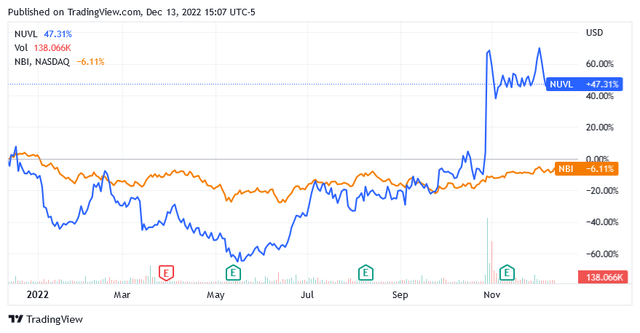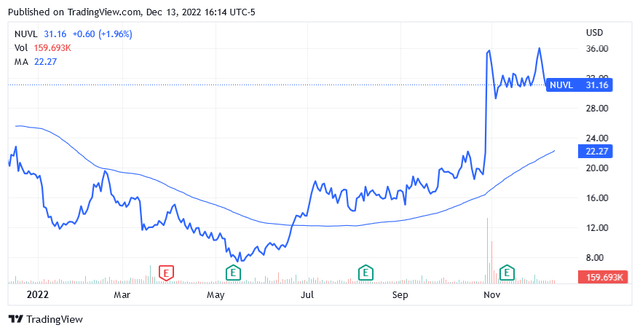Design Cells/iStock via Getty Images
In A Dull Biotech Sector, Nuvalent’s Stock Has Grown Amazingly
Judging by how its stock has performed compared to its industry, Nuvalent, Inc. (NASDAQ:NUVL) seems to be attracting a lot of interest from investors. While Nuvalent stock is up 47.3% over the past year, the biotech sector, represented by the benchmark index NASDAQ Biotechnology Index (NBI), fell 6%.
While there is some potential to bring some treatments to market for certain types of lung cancer, the pipeline still carries a significant risk of failure as the treatment candidates are still in the very early stages of development.
Investors should therefore not give in to the momentum of this exaggerated and premature uptrend in the share price, but should wait until the company’s pipeline has become more concrete and the stock is significantly cheaper than it is now.
Nuvalent In The Biotechnology Sector
Nuvalent, Inc., headquartered in Cambridge, Massachusetts, is a biopharmaceutical developer of therapies for patients with cancer. The company is still in the clinical phase, so it doesn’t sell any treatments and therefore doesn’t make a profit.
The third quarter of 2022 ended with a net loss of $19.7 million as Nuvalent incurred $14.6 million in research and development expenses and $5.8 million in general and administrative expenses.
The company develops therapies based on innovative molecules aimed at overcoming drug resistance, reducing the number and severity of side effects, and addressing brain metastases. The basic idea is to encourage more sustainable responses from future administration of the treatments.
Nuvalent is developing the following therapies to treat or prevent brain metastases in patients with non-small cell lung cancer:
- NVL-520 for use in heavily pretreated patients affected with ROS1-positive non-small cell lung cancer [NSCLC].
- NVL-655 for use in patients affected with ALK-positive NSCLC.
- NVL-330 to treat patients affected with HER2 mutant-positive NSCLC patients.
NVL-520 Versus ROS1-Positive NSCLC
ROS1-positive NSCLC refers to any patient with lung cancer who tests positive for a specific gene mutation consisting of the ROS1 gene fused to a neighboring gene. Available statistics indicate that approximately 1-2% of patients affected with NSCLC have tested positive for the above fusion, which is a cause of abnormal cell growth [cancer]. Each year, not more than 15,000 people worldwide are diagnosed with ROS1-positive NSCLC worldwide each year.
The ROS1 gene is known to the scientific community as a receptor tyrosine kinase. This is a cell surface receptor that not only plays a key role in regulating cellular processes to keep them running normally. It has also been linked to the progression of various types of cancer, including lung cancer.
It has been observed that ROS1-positive NSCLC is aggressive and has the ability to spread not only to the central nervous system [the brain] but also to the bones.
Compared to lung cancer patients in general, patients with ROS1-positive NSCLC are much younger (50-51 vs. 70 in terms of mean age) and approximately 65% of them are women.
This type of lung cancer is not related to smoking and patients are negative when tested for other lung cancer biomarkers.
Compared to other lung cancer patients, available immunotherapy appears to be less effective in ROS1-positive NSCLC patients, who are therefore advised to follow specific therapies targeting the ROS1 mutation and continue them as long as treatment is beneficial.
Regarding NVL-520 in heavily pretreated ROS1-positive NSCLC patients, the company has some preliminary data from a phase 1 study called ARROS-1, demonstrating the feasibility of the project.
NVL-655 Versus ALK-positive NSCLC
ALK-positive NSCLC refers to any patient with lung cancer who tests positive for a specific gene mutation consisting of the ALK gene fused to a neighboring gene.
ALK-positive NSCLC is a relatively rare form of lung cancer that is not commonly associated with smoking. In addition, about 50% of patients are under 50 years of age at the time of diagnosis, and most of them are women.
According to available statistics, ALK-positive NSCLC accounts for approximately 5% of all patients with lung cancer. Also, 72,000 new cases are diagnosed worldwide each year, while 64,000 is approximately the number of deaths per year.
ALK-positive NSCLC appears to be very difficult to treat and about 90% of people do not realize they have this type of lung cancer until the disease has progressed to stage IV. ALK-positive NSCLC patients have a 50 percent chance of living longer than 7 years if their stage IV is treated.
Regarding NVL-655 as an ALK-selective inhibitor in ALK-positive NSCLC patients and other solid tumors, Nuvalent has some preclinical data from a Phase 1/2 study called ALKOVE-1. NVL-655 may have a selective inhibitory effect on the ALK gene and some of its variants, meaning there is potential for an effective treatment that avoids certain central nervous system side effects and leads to more sustainable benefits for patients.
NVL-330 Versus HER2 mutant-positive NSCLC
HER2 gene mutations are more commonly found in NSCLC patients. Also, these patients are mostly young women, although their condition is not associated with smoking.
HER2 mutant-positive NSCLC accounts for approximately 2% of all lung cancer patients.
The company has some data from preclinical testing that suggests certain characteristics indicative of NVL-330 as a potential treatment or prevention of brain metastases in NSCLC patients with HER2 mutant-positive.
According to Nuvalent, about 19% of NSCLC patients with HER2 mutant-positive already have brain metastases when the disease is diagnosed, and many others will develop the disease over the course of lung cancer treatment.
The Financial Condition of The Company
As of September 30, 2022, cash and short-term investments totaled $240.1 million, to be supplemented by funds that Nuvalent will raise through the issuance of new equity. Nuvalent intends to raise approximately $200 million through this type of corporate transaction.
Thereafter, according to the company, there will be sufficient resources to sustain the development of the treatment pipeline through 2025.
The balance sheet is not burdened with debt.
The Stock Valuation
After an impressive 47.3% jump over the past year, shares of Nuvalent, Inc. are trading well above the long-term trend of the 100-day moving average of $22.27 and well above the median of $23.76 of the 52-week range of $7.09 to $40.43.
As of this writing, shares are trading at $31.16 apiece, giving a market cap of $1.72 billion.
At this point, there is a risk that shares could pull back significantly to lower price levels if the market sees current valuations as disproportionate compared to the portfolio of treatments under development.
Anything is possible in the markets but based on portfolio analysis of the treatments in development, shares are unlikely to rally much higher from these levels.
Therefore, investors should consider selling Nuvalent’s stock when the purchase price implies a good margin of return.
Conclusion
Nuvalent is developing 3 treatments aimed at stopping certain gene mutations from causing metastases in the central nervous system of people with a type of lung cancer called non-small cell lung cancer.
The stock has grown strongly over the past 12 months, despite all the well-known market headwinds that have put severe downward pressure on the entire biotech sector.
As a result, Nuvalent, Inc. stock appears overvalued compared to its portfolio of treatments in development, which are at best in a proof-of-concept stage and target certain aspects of rare forms of lung cancer.
In addition, these forms of lung cancer are very rare in the world population because they are not associated with the highest health risk behavior among people, namely tobacco use.




Be the first to comment